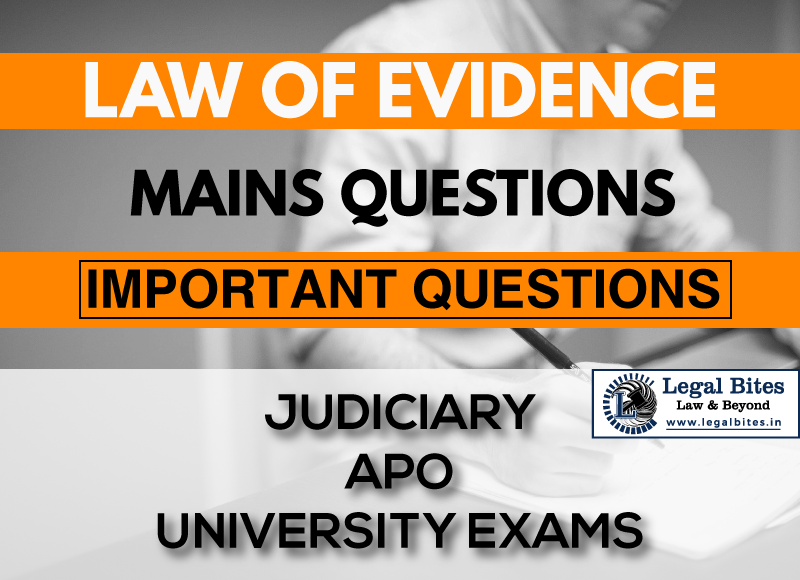Discuss the term ‘Evidence’. Explain the different kinds of evidence recognized under the Indian Evidence Act.
Find the answer to the mains question of the Law of Evidence only on Legal Bites.

Question: Discuss the term Evidence. Explain the different kinds of evidence recognized under the Indian Evidence Act. [Bihar. J. 2000, C.G.2003] Find the answer to the mains question of the Law of Evidence only on Legal Bites. [Discuss the term ‘Evidence’. Explain the different kinds of evidence recognized under the Indian Evidence Act. [Bihar. J. 2000, C.G.2003]] Answer The term “Evidence” has been defined in Section 3 Indian Evidence Act as:- “Evidence” means...
Question: Discuss the term Evidence. Explain the different kinds of evidence recognized under the Indian Evidence Act. [Bihar. J. 2000, C.G.2003]
Find the answer to the mains question of the Law of Evidence only on Legal Bites. [Discuss the term ‘Evidence’. Explain the different kinds of evidence recognized under the Indian Evidence Act. [Bihar. J. 2000, C.G.2003]]
Answer
The term “Evidence” has been defined in Section 3 Indian Evidence Act as:-
“Evidence” means and includes –
- all statements which the court permits or requires to be made before it by witnesses, in relation to matters of fact under inquiry; such statements are called oral evidence;
- all documents produced for the inspection of the court such documents are called documentary evidence.”
The term “evidence” means instruments by which relevant facts are brought before the court. Expression “Evidence” Signifies the state of being evident.
According to prof. Green Leaf –
“evidence in legal acceptation includes all the means by which any alleged matter of fact, the truth of which is submitted to investigation, is established or disproved.”
The different kinds of evidence recognized under the Indian Evidence Act are listed as below:
1. Oral Evidence- Oral evidence means a statement made by a witness before a court in relation to the matter of fact under inquiry. So oral evidence is such a deposition of witnesses who have witnessed the facts or who became acquainted with the facts they are deposing and which has to be recorded by the court.
Sections 59 and 60 of the India Evidence Act mainly deals with oral evidence other than that there are many sections in the act that also deals with oral evidence such as sections 22 and 22A deal with oral admissions and chapter 6 of the Indian evidence act which deals with the exclusion of oral by documentary evidence.
2. Documentary Evidence- The 'documentary evidence’ is a document produced for the inspection of the court or the judge. A document is evidence only when it is produced for the inspection of the court. Documentary evidence is dealt with in sections 61 to 90A of the Indian Evidence Act, 1872.
Sections 61 to 73A deal with the general rules for proving documentary evidence in various cases, sections 74 to 78 deal with public documents, and sections 79 to 90-A deal with presumptions as to documents.
3. Direct Evidence- Direct or positive evidence is evidence about the real point of controversy. Oral evidence must be always direct. The evidence is direct if the court to set upon it has to rely upon only the witness whereas it is hearsay if it has to rely upon not only the witness but some other persons also.
4. Circumstantial Evidence- 'Circumstantial Evidence’ means evidence relating to series of circumstances which if taken together, assist the court to come to any determination, in the absence of any eyewitness evidence. Circumstantial evidence is not to be confused with hearsay or secondary evidence. The circumstantial evidence is always direct but proves any relevant circumstance.
Normally facts that could be seen are proved by an eye witness, but sometimes in the absence of any eye witness to give the eye witness version, the court relies on series of circumstances that assist the court to determine the fact in issue. When a witness has not seen the commission of a crime by the accused, then the court can rely upon surrounding circumstances before or after the commission of a crime which connects the accused with the crime.
State of U.P. v. Satish, Appeal (Crl.) 256-257 of 2005, the Supreme Court emphasized that circumstantial evidence can be considered a reliable source of evidence, when the chain of circumstances leads to complete, coherent, and leads to a single conclusion that ultimately proves the guilt of the accused.
Important Mains Questions Series for Judiciary, APO & University Exams
- Law of Evidence Mains Questions Series Part-I
- Law of Evidence Mains Questions Series Part-II
- Law of Evidence Mains Questions Series Part-III
- Law of Evidence Mains Questions Series Part-IV
- Law of Evidence Mains Questions Series Part-V
- Law of Evidence Mains Questions Series Part-VI
- Law of Evidence Mains Questions Series Part-VII
- Law of Evidence Mains Questions Series Part-VIII
- Law of Evidence Mains Questions Series Part-IX
- Law of Evidence Mains Questions Series Part-X
Admin Legal Bites
Legal Bites Study Materials correspond to what is taught in law schools and what is tested in competitive exams. It pledges to offer a competitive advantage, prepare for tests, and save a lot of money.
